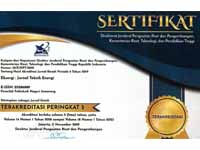Operational Assessment of Shell and Tube High Pressure Heater in PT Sumber Segara Primadaya's 300 MW Unit 2 Power Plant
DOI:
https://doi.org/10.32497/eksergi.v21i01.6361Keywords:
High-pressure heater, shell-and-tube heat exchanger, thermal efficiency, PLTUAbstract
Electricity is a fundamental necessity, with Indonesia's per capita consumption reaching 1.73 kWh/capita in 2022—a 4% increase from 2021 and the highest in five decades. Projections indicate demand will surge to 1,885 TWh by 2060, with per capita consumption exceeding 5,000 kWh, underscoring the need for efficient power generation. In coal-fired power plants (PLTU), high-pressure shell-and-tube heat exchangers are critical for optimizing efficiency, recovering waste heat to preheat boiler feedwater, reducing fuel use by 5–10%, and minimizing emissions. This study evaluates the performance of these heat exchangers at PT Sumber Segara Primadaya PLTU Cilacap, a major Indonesian PLTU with units totaling 2,260 MW capacity. By analyzing operational effectiveness, this research aims to enhance maintenance strategies and maximize energy output, supporting Indonesia's growing electricity demands while improving thermal efficiency in coal-dependent power systems.
References
10.1016/j.nucengdes.2019.110183.
[10] J. H. Kim, M. M. Song, and S. A. Alameri, “Emerging areas of nuclear power applications,” Nuclear Engineering and Design, vol. 354, p. 110183, Dec. 2019, doi: 10.1016/j.nucengdes.2019.110183.
[11] Y. Sui and W. Wu, “Ionic liquid screening and performance optimization of transcritical carbon dioxide absorption heat pump enhanced by expander,” Energy, vol. 263, p. 125689, Jan. 2023, doi: 10.1016/j.energy.2022.125689.
[12] D. Zhang, X. Han, H. Wang, Q. Yang, and J. Yan, “Experimental study on transient heat/mass transfer characteristics during static flash of aqueous NaCl solution,” Int J Heat Mass Transf, vol. 152, p. 119543, May 2020, doi: 10.1016/j.ijheatmasstransfer.2020.119543.
[13] Z. Chu, K. Dong, P. Gao, Y. Wang, and Q. Sun, “Mine-oriented low-enthalpy geothermal exploitation: A review from spatio-temporal perspective,” Energy Convers Manag, vol. 237, p. 114123, Jun. 2021, doi: 10.1016/j.enconman.2021.114123.
[14] S. Lee, T. kyun Kim, C. min Park, M. Hwan Kim, and H. Jo, “The effect of heater dimensions with different liquid penetration lengths to dry spots on critical heat flux,” Appl Therm Eng, vol. 213, p. 118754, Aug. 2022, doi: 10.1016/j.applthermaleng.2022.118754.
[15] M. Misale and J. A. Bocanegra, “Experiments and qualitative analysis by artificial neural network approach on pool boiling of FC-72 on finned surfaces confined by an unheated horizontal wall,” International Journal of Thermal Sciences, vol. 187, p. 108105, May 2023, doi: 10.1016/j.ijthermalsci.2022.108105.
Downloads
Published
Issue
Section
License
Copyright (c) 2025 Mulyono Mulyono, Erwan Tri Efendi, Rayhan Muhammad Faqi Fikar Setiyawan, Dianisa Khoirum Sandi, Dhiyaussalam Dhiyaussalam

This work is licensed under a Creative Commons Attribution 4.0 International License.
Authors who publish with this journal agree to the following terms:Authors retain copyright and grant the journal right of first publication with the work simultaneously licensed under a Creative Commons Attribution License that allows others to share the work with an acknowledgement of the work's authorship and initial publication in this journal.
Authors are able to enter into separate, additional contractual arrangements for the non-exclusive distribution of the journal's published version of the work (e.g., post it to an institutional repository or publish it in a book), with an acknowledgement of its initial publication in this journal.
Authors are permitted and encouraged to post their work online (e.g., in institutional repositories or on their website) prior to and during the submission process, as it can lead to productive exchanges, as well as earlier and greater citation of published work (See The Effect of Open Access).






